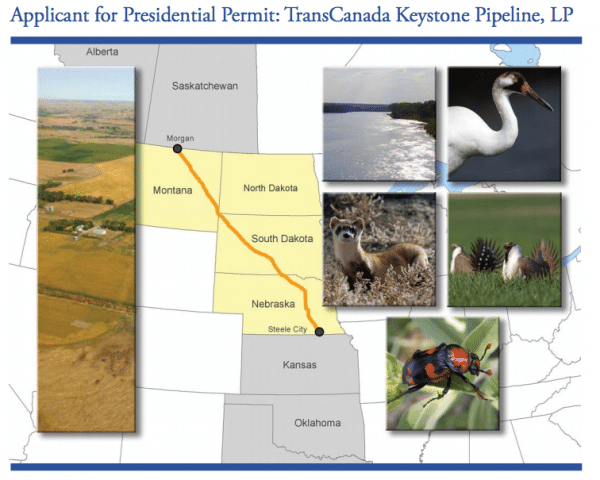With the State Department’s release of the final Keystone XL environmental review, attention is being refocused on apparent conflicts of interest within both the State Department itself and the consultancy hired to conduct the review.
Upon the release of the review – which is formally called the final supplemental environmental impact statement (or FSEIS) – Tom Steyer of NextGen Climate urged Secretary of State John Kerry to begin a formal review of the “defective” environmental analysis. In his February 2 letter to Secretary Kerry, Steyer writes that “It is inappropriate and unfair to provide President Obama … with a report that is not only on its face defective, but which has suffered from a process that raises serious questions about the integrity of the document.”
The review, argues Steyer, “has suffered from a process that raises serious questions about the integrity of the document.”
In his letter, Steyer lays out the following problems, which he argues undermine the entirety of the environmental impact statement:
- The hiring of a TransCanada contractor – Environmental Resources Management (ERM) – to write the FEIS.
- ERM‘s problematic representations about its ties to the tar sands industry on its conflict of interest disclosure form.
- The Inspector General’s investigation into this deception, an action taken only after persistent pressure from public interest groups.
- Additional conflicts (here, here and here) that have come to light since the Inspector General’s investigation began.
- Repeated quotes (e.g., here and here) to news outlets from named and unnamed staff members at the State Department boasting of “rigorous conflict of interest procedures…” that “… ensure that no contractors or subcontractors have financial or other inappropriate interests in the outcome of a project.” This assertion continued to be made even after the Inspector General’s investigation was announced.
- The unsurprising tilt of the draft FEIS toward ERM‘s client, TransCanada.
- The interagency criticism (here and here) that the draft EIS drew because of its deep flaws.
- The nearly identical nature of the final FEIS to the draft EIS, despite significant, contradictory information coming to light after the draft version was issued. This includes ignoring the realities of tar sands transportation, and estimates that Keystone XL would produce the pollution equivalent of more than 50 coal plants – an amount no serious expert thinks can be meaningfully offset. It also ignores the $30 billion in investment by companies backed by the Chinese government.
- The apparent rush to get the EIS out the door before the Inspector General’s investigation was complete – despite a recent request by over 20 House members asking that the FEIS be held until the investigation was completed.
The close ties between ERM and TransCanada have been well documented over the past year. (For a good primer, check out this easy-to-follow “Web of Deceit” graphic. For more in-depth coverage, check out DeSmogBlog’s ERM files.)
Steyer isn’t the only one expressing concern with the review. Last week, a coalition of 16 environmental organizations sent a petition to Secretary of State John Kerry, insisting that the scope of the environmental review is far too narrow and that an entirely new review is necessary.
Citing the National Environmental Policy Act, or NEPA, the groups threaten legal action if the environmental review doesn’t consider the cumulative impact of related projects, like the Keystone XL and the proposed Alberta Clipper expansion.
The groups write:
The National Environmental Policy Act (NEPA) requires that an EIS consider the cumulative impacts of the proposed federal agency action. Cumulative impacts are defined as: “the impact on the environment which results from the incremental impact of the action when added to other past, present, and reasonably foreseeable future actions regardless of what agency (Federal or non-Federal) or person undertakes such other actions.”…
The Keystone XL DSEIS fails to address the cumulative effects of Keystone XL and Alberta Clipper, especially the growth-inducing effects that the combined 1.3 million bpd of additional pipeline capacity would have on the rate of tar sands extraction in Canada.
Under NEPA, federal decisions are generally supposed to answer the question: if the project is built, how will it affect the environment, including climate change?
The final review did little to address existing criticisms about the climate related aspects of NEPA. Besides the problem of “cumulative impacts” addressed by the 16 groups above, the March 2013 draft review was widely critiqued for looking mostly at what the impact would be on greenhouse gas emissions if the project was not built – rather than what the impact would be if it were built.
NEPA and the State Department
Prospects for a comprehensive NEPA review took a big hit last month when the State Department official charged with NEPA reviews of the proposed pipeline quit the job on January 10th, to “pursue other opportunities.”
Genevieve Walker had been hired by State in 2012 to address criticisms that the review was being conducted and authored by a consultant with close industry ties. Walker was supposed to handle appeals on all NEPA-related aspects of the review. Walker’s departure leaves State without a point person for NEPA reviews.
According to Elana Schor at E&E, “Kerri-Ann Jones, assistant secretary of state for oceans and international environmental and scientific affairs, leads the bureau at the helm of the overall departmental review of KXL.”
Before Walker was hired, Jones publicly proclaimed that building Keystone XL wouldn’t result in a “dramatic change in greenhouse gas,” citing the controversial Ensys analysis that itself didn’t account for “cumulative effects” with other projects as required by NEPA. Back in August 2011, Jones told reporters.
I think that the sense we have is that this oil sands is going to be developed and therefore there’s not going to be any dramatic change in greenhouse gas from this pipeline, or if the pipeline was to go forward or without the pipeline, because the oil sands will continue to be developed and there are alternatives to pipelines to moving that fuel or potential crude around.
Now that Walker has stepped down, it is unclear who in the State Department has or will be applying the principles of NEPA to the permitting process.
Adding to the State Department’s troubles are revelations that the agency knew and acknowledged the potential conflicts of interest with contractor ERM. Politico reports this morning that State Department attorney Keith Benes wrote an email in July 2013 that included four talking points about the potential conflict. In the email to staff, Benes wrote:
“Like any other consulting firm with experience in this area, ERM has worked for multinational companies that have a variety of business interests…Among those companies are companies that may arguably benefit if the proposed project is approved or denied.”
The State Department is standing up for ERM and the review. An unnamed State Department official told Politico last night that talk of a conflict of interest is “absurd” and that ERM is a respected consultancy with thousands of employees and hundreds of diverse clients.”
A forthcoming report from the Inspector General — originally expected to be released before the final SEIS — will dive deeper into the potential conflicts of interest between ERM, TransCanada, and the State Department.
Subscribe to our newsletter
Stay up to date with DeSmog news and alerts






